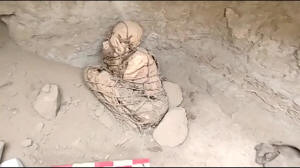|
The
mummified remains were of a person from the culture that
developed between the coast and mountains of the South American
country. The mummy, whose gender was not identified, was
discovered in the Lima region, said archaeologist Pieter Van
Dalen Luna.
"The main characteristic of the mummy is that the whole body was
tied up by ropes and with the hands covering the face, which
would be part of the local funeral pattern," said Van Dalen
Luna, from the State University of San Marcos.
The remains are of a person who lived in the high Andean region
of the country, he said. "Radiocarbon dating will give a more
precise chronology."
The mummy was found inside an underground structure found on the
outskirts of the city of Lima. In the tomb were also offerings
including ceramics, vegetable remains and stone tools, he said.
Peru - home to tourist destination Machu Picchu - is home to
hundreds of archaeological sites from cultures that developed
before and after the Inca Empire, which dominated the southern
part of South America 500 years ago, from southern Ecuador and
Colombia to central Chile.
(Reporting by Marco Aquino; Editing by Cynthia Osterman)
[© 2021 Thomson Reuters. All rights
reserved.] Copyright 2021 Reuters. All rights reserved. This material may not be published,
broadcast, rewritten or redistributed.
Thompson Reuters is solely responsible for this content.

|
|




